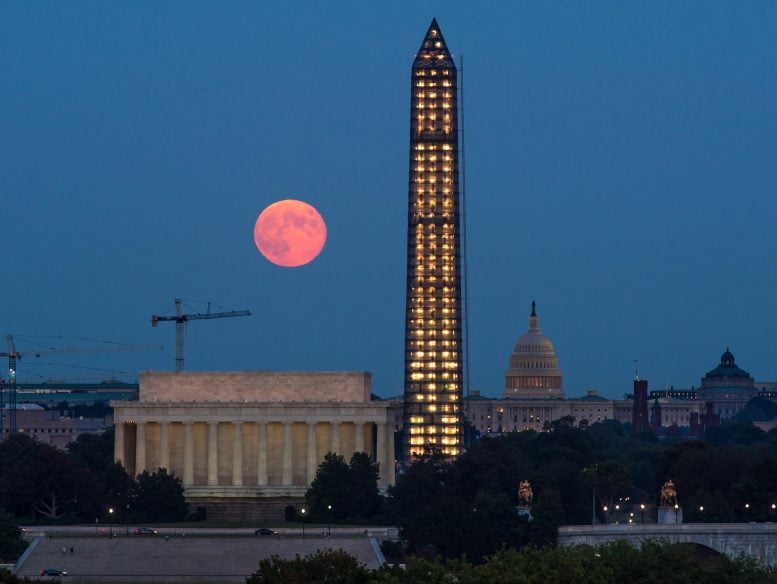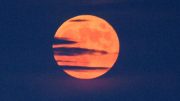
A full Moon, known as a Harvest Moon, rises over Washington on September 19, 2013. Credit: NASA/Bill Ingalls
The Next Full Moon is the Harvest Moon; the Fruit or Barley Moon; the Corn Moon; the start of the Sukkoth Holiday; the Mid-Autumn, Mooncake, or Reunion Festival Moon; the Chuseok Festival Moon; Imo Meigetsu or the Potato Harvest Moon; the start of Pitri Paksha; the Honey-offering Festival Moon; the Binara Pura Pasalosvaka Poya; and the GRAIL and LADEE Moon.
The next full Moon will be on Monday evening, September 20, 2021, at 7:55 p.m. EDT. The Moon will appear full for about three days around this time, from Sunday evening through Wednesday morning. While the full Moon will be on Monday from Iceland, Liberia, and Senegal westward across the Americas to the International Date Line, it will be on Tuesday for the rest of Africa and Europe eastward across Asia and Australia to the International Date Line.
One Moon, Many Names
As the full Moon closest to the autumnal equinox, this is the Harvest Moon, an old European name. The Oxford English Dictionary gives 1706 as the year of its first published use. Farmers sometimes need to work late by the light of the Moon for the harvest.
On average, the full Moon rises about 50 minutes later each night, but around the Harvest Moon – moonrise seems to be at nearly the same time: just 25 to 30 minutes later across the northern United States, and only 10 to 20 minutes later farther north in Canada and Europe.
Other European names for this full Moon are the Fruit Moon, as a number of fruits ripen as the end of summer approaches, and the Barley Moon, from the harvesting and threshing of the barley.
The Maine Farmers’ Almanac first published Native American names for the full Moons in the 1930s, and these names have become widely known and used. According to this almanac, as the full Moon in September – the Algonquin tribes in what is now the northeastern U.S. called this the Corn Moon, as this was the time for gathering their main staple crops of corn, pumpkins, squash, beans, and wild rice.
“Newer names for this full Moon are the GRAIL Moon and the LADEE Moon, named for two lunar robotic missions launched in September.”
– Gordon Johnston
The Moon’s Connection to Calendars
In the Hebrew calendar, this full Moon falls near the start of the 7-day Sukkoth holiday. Sukkoth is also known as the Feast of Tabernacles or the Feast of the Ingathering. This holiday ties back to the sheltering of the people of Israel during the 40 years in the wilderness in the Book of Leviticus, and also a harvest festival in the Book of Exodus. Often for this holiday, a temporary hut symbolic of a wilderness shelter is built where the family eats, sleeps, and spends time. Sukkoth will start with sundown on Monday, September 20, and end with sundown on Monday, September 27, 2021.
In China, Vietnam, and some other Asian countries, this full Moon corresponds with the Mid-Autumn Festival, a traditional harvest festival. In China, other names for this festival include the Moon Festival, the Mooncake Festival, and the Reunion Festival (with wives in China visiting their parents, then returning to celebrate with their husbands and his parents). Part of the festival includes offerings to the Moon Goddess Chang’e (the name the China National Space Agency gives their lunar missions). In Korea, this full Moon corresponds with the harvest festival Chuseok, during which Koreans leave the cities to return to their traditional hometowns and pay respect to the spirits of their ancestors.
This full Moon corresponds with the first of the two Japanese Tsukimi or “Moon-Viewing” festivals. Because of the tradition of offering sweet potatoes for the full Moon, this Moon is also called Imo Meigetsu (which translates as “Potato Harvest Moon”). The full Moon festivities have become so popular that they are often extended for several days after the full Moon. The second Moon-Viewing festival takes place on the 13th day of the next lunar month and celebrates the viewing of the waxing gibbous Moon a few days before it is full.
This full Moon marks the start of Pitri (or Pitru) Paksha (fortnight of the ancestors) during which Hindus pay homage to their ancestors, especially through food offerings. Pitri Paksha starts with the full Moon in the lunar month of Bhadrapada and ends with the new Moon.
For some Buddhists in Bangladesh and Thailand, this full Moon is Madhu Purnima, the Honey Full Moon Festival or the Honey-offering Festival, tied to a legend that an elephant and a monkey fed the Buddha when he was in the forest to bring peace between two factions, with the elephant offering fruit and the monkey offering a honeycomb.
In Sri Lanka, this full Moon is the Binara Pura Pasalosvaka Poya Day, commemorating the establishment of the Buddhist Bhikkhuni Order.
In many traditional lunisolar calendars, full Moons fall in the middle of the lunar months. This full Moon is in the middle of the eighth month of the Chinese calendar. In the Islamic calendar, the months start with the first sighting of the waxing crescent Moon shortly after the New Moon. This full Moon is near the middle of Safar, the second month of the Islamic year.
Newer names for this full Moon are the GRAIL Moon and the LADEE Moon, named for two lunar robotic missions launched in September. On September 10, 2011, the twin Gravity Recovery and Interior Laboratory (GRAIL) spacecraft started their voyage toward the Moon on a Delta II launch vehicle. On September 6, 2013, the Lunar Atmosphere and Dust Environment Explorer (LADEE) spacecraft started its journey to the Moon on a Minotaur V launch vehicle.
As usual, the wearing of suitably celebratory celestial attire is encouraged in honor of the full Moon. And you might want to consider celebrating the harvest; enjoying a mooncake; visiting your hometown, parents, and in-laws (observing appropriate social distancing, of course); and camping out with your family.
Here is a summary of other celestial events between now and the full Moon after next (with times and angles based on the location of NASA Headquarters in Washington):
The daily periods of sunlight continue to shorten as summer ends and autumn begins, changing at their fastest around the equinox on September 22, 2021. On Monday, September 20, (the day of the next full Moon), morning twilight will begin at 5:56 a.m., sunrise will be at 6:54 a.m., solar noon will be at 1:01:22 p.m. when the Sun will reach its maximum altitude of 51.94 degrees, sunset will be at 7:08 p.m., and evening twilight will end at 8:06 p.m.
Two days later on the day of the autumnal equinox – Wednesday, September 22, 2021 – morning twilight will begin at 5:58 a.m., sunrise will be at 6:56 a.m., solar noon will be at 1:00:39 p.m. when the Sun will reach its maximum altitude of 51.17 degrees, sunset will be at 7:05 p.m., and evening twilight will end at 8:02 p.m. By Wednesday, October 20, – the day of the full Moon after next – morning twilight will begin at 6:25 a.m., sunrise will be at 7:23 a.m., solar noon will be at 12:52:45 p.m. when the Sun will reach its maximum altitude of 40.55 degrees, sunset will be at 6:22 p.m., and evening twilight will end at 7:20 p.m.
The next few months should be good for Jupiter and Saturn watching, especially with a backyard telescope. Saturn was at its closest and brightest for the year on August 2 while Jupiter was at its closest and brightest on August 19 (called “opposition” because they were opposite the Earth from the Sun). While still remaining relatively bright, both will appear to shift toward the west over the coming months, making them visible earlier in the evening sky (and friendlier for backyard stargazing, especially if you have young ones with earlier bedtimes). With clear skies and a telescope, you should be able to see Jupiter’s four bright moons, Ganymede, Callisto, Europa, and Io, noticeably shifting positions in the course of an evening. For Saturn, you should be able to see Saturn’s rings as well as Saturn’s largest moon, Titan.
2021 will not be a good year for seeing the Orionid Meteor Shower due to interference from the full Moon. This shower is expected to be active from October 2 to November 7, 2021, with a peak the morning of October 21 (the day after the full Moon after the next).
Evening Sky Summary
On the evening of Monday, September 20, 2021 – the day of the full Moon – as evening twilight ends at 8:06 p.m., the brightest planet visible will be Venus, appearing as the Evening Star 7 degrees above the horizon in the west-southwest. The next brightest planet will be Jupiter, appearing 24 degrees above the horizon in the southeast. The faintest of the visible planets in the sky will be Saturn, appearing 27 degrees above the horizon in the south-southeast. The planet Mercury will have set by the time evening twilight ends, but from about 30 minutes after sunset (7:38 p.m.) until Mercury sets 14 minutes later (at 7:52 p.m) you might be able to see it low in the west-southwest. The bright star closest to overhead will be Vega, appearing 86 degrees above the western horizon. Vega is the 5th brightest star in our night sky and the brightest of the three stars in the Summer Triangle. Vega is about twice as massive as our Sun, 40 times brighter, and about 25 light-years from us.
As the lunar cycle progresses, Jupiter, Saturn, and the background of stars will appear to shift toward the west each evening (although it is actually the Earth that is moving around the Sun toward the east). The bright planet Venus will appear to shift to the left along the horizon in the southwest each evening, passing near the waxing crescent Moon on the evening of October 9 and passing above the bright star Antares on the evening of October 16, 2021. Although the planet Mercury will have set by the time evening twilight ends it may be visible in the glow of dusk low on the west-southwestern horizon for about another week (try looking about 30 minutes after sunset). When Mercury passes between the Earth and the Sun on October 9 it will shift from the evening sky to the morning sky.
By the evening of Wednesday, October 20, 2021 – the day of the full Moon after next – as evening twilight ends at 7:20 p.m., the brightest planet visible will be Venus, appearing 10 degrees above the horizon in the southwest. The next brightest planet will be Jupiter, appearing 32 degrees above the horizon in the south-southeast. The faintest of the visible planets in the sky will be Saturn, appearing 31 degrees above the horizon in the south. The bright star closest to overhead will be Deneb, appearing 81 degrees above the northeastern horizon. Deneb is about 2,600 light-years from Earth and is the 19th brightest star in our night sky.
Morning Sky Summary
On the morning of Monday, September 20, 2021 – the day of the full Moon – as morning twilight begins at 5:56 a.m. EDT, no visible planets will appear in the sky. The bright stars of the local arm of our home galaxy, including the constellation Orion, will appear high in the sky toward the south-southeast. The bright star appearing closest to directly overhead will be Capella at 81 degrees above the northeastern horizon. Although we see Capella as a single star – the 6th brightest in our night sky – it is actually the combined light of four stars (two pairs of stars orbiting each other). Capella is about 43 light-years from us.
As the lunar cycle progresses, the background of stars will appear to shift toward the west. On or after October 13 the planet Mercury will begin emerging from the glow of dawn, visible low on the eastern horizon until about 30 minutes before sunrise. After October 16 Mercury will be above the horizon as morning twilight begins. By the morning of October 20 – the day of the full Moon after next – as morning twilight begins at 6:25 a.m. EDT, the only visible planet in the sky will be Mercury, appearing about 5 degrees above the eastern horizon. The bright stars of the local arm of our home galaxy, including the constellation Orion, will appear spread across the sky from the south-southeast toward the west-northwest. The bright star appearing closest to directly overhead will be Pollux at 77 degrees above the southeastern horizon. Pollux is the brighter of the twins in the constellation Gemini and is about 34 light-years from us.
Daily Guide
Here is a more detailed, day-by-day listing of celestial events between now and the full Moon after next (again with times and angles based on the location of NASA Headquarters in Washington):
SEPTEMBER
September 16-18
Thursday night into Friday morning, September 16 to 17, 2021, the planet Saturn will appear about 5 degrees from the waxing gibbous Moon, shifting clockwise around the Moon as the night progresses. As evening twilight ends at 8:12 p.m. EDT, Saturn will appear to the upper left of the Moon. When the Moon reaches its highest in the sky for the night about 2 hours later at 10:02 p.m., Saturn will appear above the Moon. By the time the Moon sets in the west-southwest (Friday at 2:54 a.m.), Saturn will appear to the right and a little above the Moon.
Friday night into Saturday morning, September 17 to 18, 2021, the bright planet Jupiter will appear near the waxing gibbous Moon, appearing to shift clockwise around the Moon as the night progresses. As evening twilight ends at 8:11 p.m EDT, Jupiter will appear about 7 degrees to the left and a little above the Moon. Two hours and 45 minutes later, when the Moon reaches its highest in the sky for the night at 10:56 p.m., Jupiter will appear about 6 degrees above and to the left of the Moon. By the time the Moon sets in the west-southwest (Saturday at 4:04 a.m.), Jupiter will appear about 4 degrees to the upper right of the Moon.
September 20: The Next Full Moon
On Monday evening, September 20, 2021, for a short period beginning about 30 minutes after sunset after 7:38 p.m. EDT, if you have a clear view of the west-southwestern horizon you might be able to see the planet Mercury about 2 degrees above the horizon and about 1.5 degrees below the bright star Spica. Mercury will set first about 14 minutes later (at 7:52 p.m.). Because dusk will still be in the sky it may be hard to see Spica without binoculars or a telescope. This and the next evening will be the two evenings when the planet Mercury and the star Spica will appear at their closest to each other.
As mentioned above, the next full Moon will be Monday evening, September 20, 2021, at 7:55 p.m. EDT. The Moon will appear full for about 3 days around this time, from Sunday evening through Wednesday morning.
September 22: Autumnal Equinox
Wednesday afternoon, September 22, 2021, at 3:21 p.m EDT, will be the autumnal equinox –the astronomical end of summer, and the start of fall.
September 26
Sunday evening, September 26, 2021, at 5:44 p.m. EDT, the Moon will be at apogee, its farthest from the Earth for this orbit.
September 27
Monday evening, September 27, 2021, will be the last evening that the planet Mercury will appear above the horizon thirty minutes after sunset (an approximation of the last evening Mercury will be visible in the glow of dusk).
September 28
Tuesday evening, September 28, 2021, the waning Moon will appear half-full as it reaches its last quarter at 9:57 p.m. EDT. We will not be able to see the last quarter Moon (from the Washington, D.C. area) until it rises later that evening at 11:34 p.m.
OCTOBER
October 6
Wednesday morning October 6, 2021, at 7:05 a.m. EDT, will be the new Moon, when the Moon passes between the Earth and the Sun and will not be visible from the Earth. The day of – or the day after – the New Moon marks the start of the new month for most lunisolar calendars.
Sundown on Wednesday evening, October 6, 2021, marks the start of Marcheshvan in the Hebrew calendar, a name often shortened to Cheshvan or Heshvan. The Buddhist Hpaung Daw U Festival starts on the day of the new Moon and ends 18 days later, a few days past the next full Moon (on October 23, 2021). In the Hindu lunar calendar, the new Moon marks the start of the month of Ashwin, which starts with the nine-day post-monsoon harvest festival called Sharada Navaratri. In the Islamic calendar, the months traditionally start with the first sighting of the waxing crescent Moon. Many Muslim communities now follow the Umm al-Qura Calendar of Saudi Arabia, which uses astronomical calculations based on the location of Mecca to start months in a more predictable way. Using this calendar, sundown on Wednesday evening, October 6, 2021, will probably mark the beginning of Rabi al-Awwal. The ninth month of the Chinese calendar starts on Thursday, October 7, 2021 (at midnight in China’s time zone, which is 12 hours ahead of EDT).
October 7
On Thursday night, October 7, 2021, the planet Mars will be passing on the far side of the Sun as seen from the Earth, called conjunction. When planets appear near the Sun as seen from the Earth, charged particles from the Sun interfere with communications with spacecraft at that planet. This year, NASA’s solar conjunction moratorium on commanding all Mars spacecraft is between October 2 and 14.
Because Mars orbits outside of the orbit of Earth it will be shifting from the evening sky to the morning sky. Mars will begin emerging from the glow of the dawn on the eastern horizon after about October 26 (depending upon viewing conditions).
October 8
Friday afternoon, October 8, 2021, at 1:28 p.m. EDT, the Moon will be at perigee, its closest to the Earth for this orbit.
October 9
On Saturday, October 9, 2021, the planet Mercury will be passing between the Earth and the Sun as seen from the Earth, called inferior conjunction. Planets that orbit inside of the orbit of Earth can have two types of conjunctions with the Sun, inferior (when passing between the Earth and the Sun) and superior (when passing on the far side of the Sun as seen from the Earth). Mercury will be shifting from the evening sky to the morning sky and will begin emerging from the glow of the dawn on the eastern horizon after about October 13 (depending upon viewing conditions).
On Saturday evening, the waxing crescent Moon and the bright planet Venus should make a pleasing sight in the southwestern sky. As evening twilight ends at 7:35 p.m., the Moon will appear about 11 degrees above the horizon with Venus appearing about 2.5 degrees to the lower right of the Moon and the bright star Antares appearing about 6 degrees to the left. Venus will set first in the west-southwest about an hour later at 8:35 p.m.
October 12
On Tuesday night, October 12, 2021, the Moon will appear half-full as it reaches its first quarter at 11:25 p.m. EDT. For the Washington area, at least, this will be just before moonset at 11:38 p.m.
October 13-14
Wednesday morning, October 13, 2021, will be the first morning that the planet Mercury will appear above the horizon 30 minutes before sunrise, an approximation of when it will begin emerging from the glow of dawn and start being visible low on the eastern horizon. Mercury passed between the Earth and the Sun on October 9, moving from the evening sky to the morning sky.
Wednesday evening into early Thursday morning, October 13 to 14, 2021, the planet Saturn will appear above the waxing gibbous Moon. Saturn will appear about 8 degrees to the upper left of the Moon as evening twilight ends at 7:30 p.m EDT. Saturn will appear to shift clockwise around the Moon as the night progresses, appearing about 6 degrees to the upper right of the Moon as the Moon sets in the west-southwest shortly after midnight (Thursday morning at 12:45 a.m.).
October 15
The next night, Thursday evening into early Friday morning, October 14 to 15, 2021, the bright planet Jupiter will appear above the waxing gibbous Moon. Jupiter will appear about 9 degrees to the upper left of the Moon as evening twilight ends (at 7:28 p.m. EDT). Jupiter will appear to shift clockwise around the Moon as the night progresses, appearing about 7 degrees to the upper right of the Moon as the Moon sets in the west-southwest about 2 hours after midnight (Friday morning at 1:54 a.m.).
By Friday evening, October 15, the waxing gibbous Moon will have shifted such that Jupiter will appear about 9 degrees to the upper right of the Moon as evening twilight ends at 7:27 p.m. EDT. The pair will appear to separate as the night progresses.
October 16: Observe the Moon Night
Saturday morning, October 16, 2021, will be the first morning that the planet Mercury will appear above the eastern horizon at the time morning twilight begins at 6:46 a.m. EDT.
Saturday evening, the bright star Antares will appear below the even brighter planet Venus. As evening twilight ends at 7:26 p.m. EDT, Venus will appear 10 degrees above the southwestern horizon with Antares 1.4 degrees below Venus. Antares will set about an hour later at 8:25 p.m. Throughout this lunar cycle, Venus will be shifting to the left along the horizon while the background of stars rotates to the west. These two apparent motions will cause Venus to shift toward Antares until October 16, after which the pair will appear to separate as Venus continues to the left and Antares continues towards the horizon each evening.
Saturday night is also International Observe the Moon Night. Click the link to find out about events near you, and to find out about hosting an event.
October 20
The full Moon after next will be Wednesday morning, October 20, 2021, at 10:57 a.m. EDT. The Moon will appear full for about 3 days around this time, from Monday night through Thursday morning – and possibly the earlier part of Thursday evening.









Be the first to comment on "Don’t Miss the Harvest/GRAIL Moon + Other Notable Celestial Events"